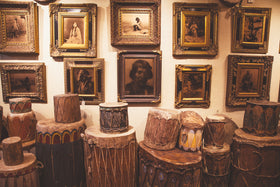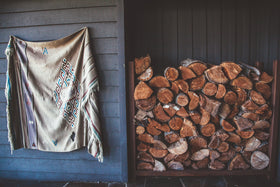Maria Martinez Historic Blackware Pottery


Julian and Maria Martinez, San Ildefonso Pueblo, n.d.
Wyatt Davis (American, born 1906) gelatin silver print, 8 x 10 in. (20.3 x 25.4 cm)
Courtesy Palace of the Governors Photo Archives (NMHM/DCA) #4591
Maria and Julian Martinez, of the San Ildefonso Pueblo, New Mexico, are internationally renowned 20th-century American potters. Inspired by the findings of archeologists, Maria and her husband led a revival of ancient pottery styles among Pueblo artisans. Between 1918 and 1943, Maria shaped the pots and her husband Julian painted the designs. He was the first acknowledged male artist of their Pueblo to do so.
In 1908, Dr. Edgar Hewett, New Mexico archaeologist and director of the Laboratory of Anthropology in Santa Fe, had excavated some 17th century black pottery shards on the Pajarito Plateau in north central New Mexico. Seeking to revive this type of pottery, Hewett encouraged local potters, to recreate the shapes of ancient pots. During this time Julian Martinez was hired by Hewett to help with the excavation. Julian’s wife Maria was an established potter and was also encouraged to reproduce the ancestral pottery. Soon after, Maria and Julian began a decade long experimentation that led to what is now known as the San Ildefonso style of traditional pottery. Maria made the pots by the ancient method of hand coiling clay while Julian assisted in the gathering of the clay, building of the fires, and the decorating of the pottery.

Maria Martinez at Her Kiln
Creating blackware pottery is a long and difficult process that requires patience and skill. Through trial and error Maria and Julian rediscovered this forgotten art. Most importantly, they found that smothering a cool fire with dried horse manure would trap the smoke. This method of fire reduction caused the red-brown clay pots to turn black. Creating blackware was one aspect, mastering the decorating techniques was another. How do you decorate this style of pottery when you can’t polish a design into a black background? Through experimentation, Julian discovered that by mixing clay and juice from the Bee plant, he could create a paint or “slip” with which he could decorate the pottery. When fired, the mixture burned off leaving behind the matte decoration.

Julian Martinez Blackware Jar with Avanyu Design
In 1918 Julian completed the first decorated blackware pot with a matte background and a polished Avanyu design. Many of Julian’s decorations were adopted from ancient Pueblo vessels and consisted of birds, feathers, clouds, rain, mountains and kiva steps.
Although they periodically created pottery with colored designs, the couple gained a reputation for their work with black pottery. Their rise in popularity may be due, in part, to the smooth, geometric shapes which matched the art deco style of the 1930’s and 40’s. Maria was once quoted saying, “Black goes with everything.”

Julian, Maria and Family
Maria had a strong connection to her pueblo of San Ildefonso and preferred living a traditional tribal life in her ancestral home over selling her pottery in Santa Fe. Following her husband’s death in 1943, Maria’s sons Popovi Da, and Adam, as well as her daughter-in-law Santana assisted in the continuation of her work. Between 1943 and 1954, Adam and Santana helped with the design and firing of her pottery while Popovi Da assisted in the gathering of the clay and paints. Around 1956, Popovi Da began helping with the decorating and painting of the pottery.
Throughout her life, Maria Martinez won many awards and presented her pottery at many world fairs. In 1973 she received the initial grant for the National Endowment for the Arts to fund a Martinez pottery workshop. Martinez passed on her knowledge and skill to many others including family, women in her pueblo, and students outside the pueblo. In 1932 she was asked to teach by the Government Indian school in Santa Fe but refused stating, “I come and I work and they can watch.” Her family members had not taught her, so she would not do so either.

Maria Martinez Pottery Signatures
Signatures on Maria’s pottery vary depending on who she was working with at the time. From 1918-1923, pieces made by Maria and Julian are unsigned. In 1923 Maria began signing her name “Marie.” From 1925 to Julian’s death in 1943, their pottery was signed “Marie + Julian.” From 1943-1954 her pottery was signed both “Marie + Santana,” or “Maria + Santana.” When her son began helping in 1956 pieces were signed “Maria/Popovi.” In 1959 the addition of the month and year of firing was added to the signature. One last signature can be found on authentic Maria pottery. At times Maria made smaller, undecorated pieces on her own, these were signed “Maria Poveka,” a throwback to her maiden name Maria Poveka Montoya.
Over the years Cisco’s Gallery has amassed a large collection of San Ildefonso and Santa Clara black-on-black pottery. In addition to our collection, we have the honor of displaying an equally large selection of never-before-seen Maria blackware. Each piece was hand-wrapped by Maria and stored until recently. These amazingly pristine pieces of blackware pottery are being offered for sale for the first time and can be purchased online at ciscosgallery.com. To view the works in person, stop by our brick and mortar location in downtown Coeur d’ Alene, Idaho.




